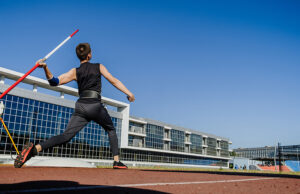Elbow Injuries in Throwing Athletes Treated in Arlington, VA

Elbow pain is common. The experienced orthopedic specialists at Nirschl Orthopaedic Center in Arlington, Virginia, offer the latest diagnostic and treatment options for elbow injuries, which frequently affect throwing athletes. Why? These individuals participate in sports that involve repetitive arm motions that can stress the elbow joint, which connects the upper arm bone (humerus) to the forearm bones (radius and ulna) and allows the arm to bend. Some examples include baseball, softball, tennis, bowling, gymnastics, darts, horseshoes, shot put, javelin, discus, and hammer throwing.
Common Elbow Injuries
Using their arm and hand strength, throwing athletes repeatedly propel objects forward or into the air at high velocity. This can strain the bones, muscles, ligaments, tendons and nerves that make up the elbow joint, leading to injuries such as:
- Flexor tendinitis – Overhead throwing can strain the tendons attached to the flexor/pronator muscles in the forearm, leading to pain and inflammation on the inside of the elbow.
- Ulnar collateral ligament (UCL) injuries – The UCL, which runs alongside the ulna and connects to the base of the humerus, absorbs considerable stress from throwing, which can cause inflammation and tiny tears.
- Ulnar neuritis – A long nerve that spans from the hand through the elbow and upper arm, the ulnar nerve can stretch out of place and become irritated.
- Olecranon stress fractures – The bony point of the elbow, the olecranon endures stress along with the surrounding muscles and can eventually sustain small cracks.
- Valgus extension overload – Over time, the repetitive pushing together of the humerus and olecranon can wear away the cartilage that cushions the elbow joint. As a result, bone spurs may form on the olecranon, which can cause painful swelling in the elbow.
How Are Elbow Injuries Treated?
After determining the source of the pain, testing the elbow’s range of motion and evaluating the integrity of the surrounding soft tissues, an elbow specialist at Nirschl Orthopaedic Center can suggest an appropriate treatment plan for a throwing athlete.
Treatment can vary depending on the type and severity of the injury. In addition to PRICE therapy (protection, rest, ice applications, compression and elevation), conservative options include nonsteroidal anti-inflammatory drugs (NSAIDs), physical therapy and improved throwing mechanics. In severe cases, surgery may be considered. Two possible procedures include:
- Elbow arthroscopy – A surgeon makes several small incisions, then inserts a miniature camera to examine the interior of the elbow for bony growths, damaged ligaments and tendons and loose pieces of bone and cartilage. The surgeon may repair the damage using narrow instruments inserted through the small incisions, eliminating the need to make a single, large incision.
- UCL reconstruction (“Tommy John” surgery) – A surgeon fits a torn UCL with a tissue graft derived from a nearby tendon, allowing a new ligament to grow and reconstruct the damaged one.
Elbow injuries can cause considerable pain and interfere with your ability to succeed at the sports you enjoy. At Nirschl Orthopaedic Center, we understand how important it is for throwing athletes to get back on the field or in the gym. Our elbow specialists are prepared to meet your needs with a variety of innovative treatments depending on your individual case.
To request an appointment in Arlington, VA, contact Nirschl Orthopaedic Center at (703) 525-2200 today.
